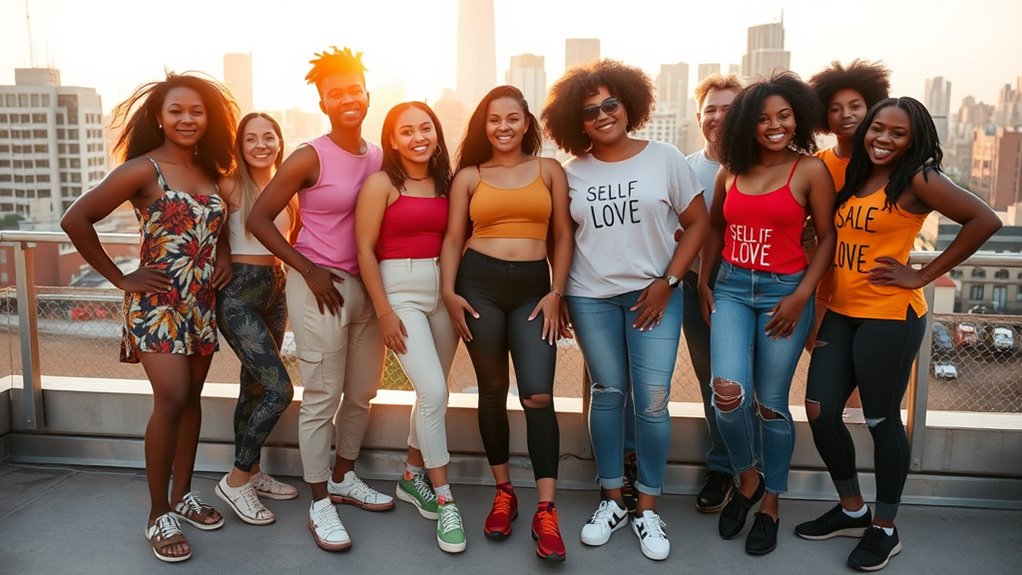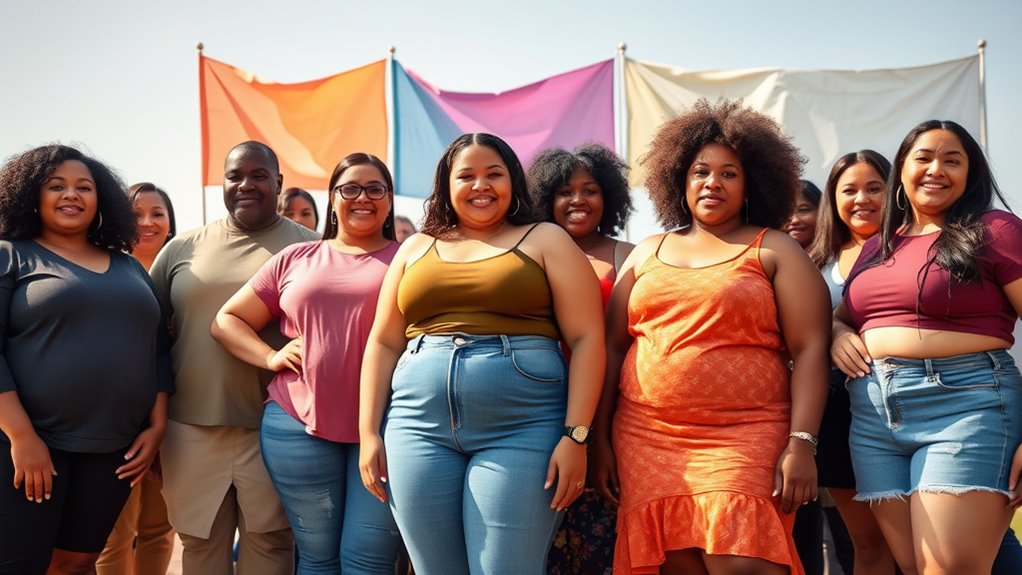Online movements promoting body positivity and neutrality encourage you to challenge societal beauty standards and embrace your unique body. These initiatives help you develop self-acceptance by shifting focus from appearance to your body’s functions and strengths. They empower you to see beauty in diversity, reject harmful narratives, and foster resilience. By supporting these movements, you’ll discover ways to cultivate a compassionate, balanced view of yourself—if you keep exploring, you’ll find practical tools to enhance your self-relationship.
Key Takeaways
- Online movements promote diverse representation to challenge narrow beauty standards and foster acceptance of all body types.
- Social media platforms serve as spaces for body positivity communities sharing stories, affirmations, and supportive content.
- Hashtags like #BodyPositivity and #BodyNeutrality amplify awareness and encourage widespread participation.
- Influencers and creators advocate for self-love, mental health, and resilience against media-driven beauty ideals.
- Digital campaigns empower individuals to redefine beauty norms and embrace body diversity through education and sharing.

Body positivity and neutrality are essential movements that encourage you to accept and appreciate your body as it is, regardless of societal standards. These movements challenge the often unrealistic media representation that bombards you daily, showing narrow ideals of beauty that can make you feel inadequate or self-critical. By recognizing how media influences perceptions—whether through social media, advertisements, or celebrity images—you can start to see that these portrayals don’t reflect the diversity of real bodies. This awareness is a crucial step in developing self-acceptance strategies that help you counteract external pressures. Instead of comparing yourself to curated images, you learn to focus on your body’s unique qualities and strengths, fostering a healthier relationship with yourself.
Embrace your unique qualities and challenge media standards to foster a healthier, more accepting relationship with your body.
Media representation plays a significant role in shaping your perceptions of beauty and worth. When you’re constantly exposed to images that idealize certain body types, it’s easy to internalize those standards as the only acceptable way to look. This can lead to feelings of inadequacy, body shame, or the desire to alter your appearance. Recognizing that media often promotes a narrow, often unrealistic view helps you detach your self-worth from these images. It’s empowering to seek out and follow diverse content creators who showcase different body sizes, shapes, and abilities. This broader representation can help you see that beauty exists in many forms and that you don’t need to conform to a limited standard to be valued. Understanding media influence is essential for fostering this awareness.
Self-acceptance strategies are crucial in cultivating body neutrality and positivity. These include practices like mindfulness, where you focus on your body’s functions rather than its appearance, and affirmations that reinforce your worth beyond looks. Moving away from obsessive body scrutiny and adopting a neutral stance—acknowledging your body’s presence without judgment—can substantially improve your mental health. Engaging in activities that make you feel good, like movement or hobbies, shifts your focus from appearance to experience. Additionally, cultivating a supportive environment by surrounding yourself with positive influences and rejecting harmful narratives helps reinforce your journey toward self-love. Over time, these strategies enable you to see your body as a vehicle for expression and connection, rather than an object to be judged.
In essence, embracing body positivity and neutrality requires conscious effort—challenging media narratives, practicing self-acceptance strategies, and redefining your standards of beauty. You’re not alone in this journey; many online movements provide support and inspiration as you learn to appreciate your body’s individuality. By staying mindful of how media representation influences you and actively choosing to celebrate your body, you foster resilience against societal pressures. Ultimately, this process leads to a more compassionate, balanced view of yourself—one rooted in acceptance and genuine appreciation.
Frequently Asked Questions
How Can I Start Practicing Body Neutrality Daily?
To start practicing body neutrality daily, focus on self-acceptance strategies like acknowledging your body’s functions rather than its appearance. Incorporate daily affirmation routines such as reminding yourself of what your body allows you to do, not how it looks. Avoid negative self-talk and instead, celebrate small victories. Consistency is key; over time, you’ll develop a healthier relationship with your body and foster greater self-compassion.
What Are Common Misconceptions About Body Positivity?
Many believe body positivity means loving every part of your body, but that’s a misconception. For example, media representation often promotes unrealistic societal standards, making people think positivity requires perfection. In reality, body positivity is about accepting your body as it is, flaws and all. It’s not about loving every inch, but recognizing your worth beyond societal standards and challenging harmful stereotypes.
How Do Online Movements Influence Real-Life Body Image?
Online movements shape your real-life body image through social media activism and influencer impact. When you see diverse bodies celebrated and authentic stories shared, you’re more likely to develop a positive view of yourself. However, if you follow unrealistic standards or compare yourself to curated content, it can harm your confidence. Staying mindful of these influences helps you embrace your unique body and stay grounded amid online messages.
Can Body Neutrality Improve Mental Health?
Imagine standing in front of a mirror, feeling calmer and more at peace with what you see. Body neutrality can markedly improve your mental health by helping you develop self-acceptance strategies and fostering a kinder view of your body. Media literacy techniques empower you to critically analyze unrealistic images, reducing comparison and boosting your confidence. Embracing body neutrality allows you to focus on your well-being rather than appearance.
What Are Effective Ways to Combat Online Body Shaming?
To combat online body shaming, you should focus on promoting positive messages through social media campaigns that celebrate all bodies. Celebrity influence can be powerful; encourage influencers to speak out against shaming and share their own stories. You can also report harmful comments and support others who are targeted. By actively engaging in these efforts, you create a safer online space and challenge negativity directly.
Conclusion
Think of body positivity and neutrality as your guiding compass on a vast, unpredictable sea. As you navigate waves of judgment and self-doubt, these movements become your steady lighthouse, shining light on your worth beyond appearances. Embrace them as your trusted map, helping you steer toward self-love and acceptance. Remember, with every tide you ride, you’re charting a course toward a kinder, more understanding you—where every body is a cherished island in a boundless ocean.










